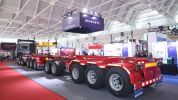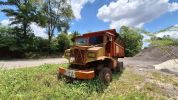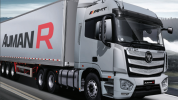Asian Trucker Forum: The Electrified Malaysian Transport Industry, Part 1: Powertrains

A powertrain is a system inside a truck. Depending on the kind of truck, it’s size and application, these systems have specific subsystems, while the general purpose of the powertrain is to propel the vehicle forward. In a truck, a powertrain consists of the engine or motor and its internal components, such as the energy storage system, transmission and driveshaft.
Currently, the most commonly used source of power to propel a truck is an internal combustion engine. With the introduction of electricity as a source of power to propel a truck, a new generation of powertrains is being used.
Electric drive trains for trucks come in several forms, each with unique configurations and benefits, optimized for various applications, ranging from urban delivery vehicles to heavy-duty long-haul trucks. The following types of powertrains can be found in modern vehicles:
Battery Electric Vehicles (BEV)
BEVs use large battery packs to store electrical energy, which powers an electric motor. The batteries are recharged by plugging into the grid or through regenerative braking. Since they don’t rely on internal combustion, BEVs produce no tailpipe emissions, making them environmentally friendly. Currently, the weight of the batteries and are somewhat limiting the payload. With lighter batteries, this will however change in the future.
Electricity is typically cheaper than diesel or gasoline, and maintenance is simpler because there are fewer moving parts (no engine oil, transmission fluid, etc.). A cost analysis whereby various kinds of energy sources are compared needs to be done for each market in order to be able to define which is the cheaper alternative. In a recent case study, Asian Buses found that BEV buses are cheaper to operate in specific environments after a threshold of years has been passed.
Electric motors produce much less noise than traditional internal combustion engines. This is an important aspect for urban planners and healthcare practitioners. Constant and loud noises have a negative impact on the health of drivers as well as those living in cities.
Electric motors provide maximum torque from a standstill, enhancing acceleration, which is particularly beneficial for heavy loads. Meanwhile, the behaviour of electric powertrain necessitates a new generation of tyres that need to be designed to cope with the drastically faster acceleration and deceleration.
For now, an issue that is discussed is the range of a BEV / charging times as these are impacting the operation of transporters. Currently, charging a BEV is not as convenient as filling up a tank with Diesel.
Fuel Cell Electric Vehicles (FCEV)
In a variation of the BEVs, FCEVs use hydrogen fuel cells to generate electricity on board. The fuel cell converts hydrogen into electricity, which powers the electric motor. Through the use of Hydrogen fuel cells, FCEV typically provide longer driving ranges compared to battery-electric trucks, making them suitable for long-haul routes.
Hydrogen can be refueled in minutes, similar to diesel, offering much faster turnaround times compared to battery charging. One needs to consider Hydrogen being a gas, thus needing different treatment compared to Diesel for example. Hydrogen used in the fuel cells is a very flammable gas and can cause fires and explosions if it is not handled properly. Hydrogen is a colourless, odourless, and tasteless gas. Natural gas and propane are also odourless, but a sulfur-containing (Mercaptan) odorant is added to these gases so that a leak can be detected.
The only by-product of hydrogen fuel cells is water vapor, so they are environmentally friendly.
Plug-In Hybrid Electric Vehicles (PHEV)
PHEVs combine a smaller battery with a conventional internal combustion engine (ICE). The truck can operate on electricity for shorter distances and switch to the combustion engine for longer trips. The combination of electric and combustion power allows for extended ranges compared to fully electric trucks. Stemming from passenger cars, this technology may be easier to apply to light commercial vehicles, used in urban environments.
PHEVs offer operators a lot of flexibility. As the driver can switch between electric mode in cities (reducing emissions) and traditional combustion for longer routes, PHEV are well suited for intercity missions.
Even though they use a combustion engine, PHEVs can significantly reduce fuel consumption, especially on shorter trips. This technology would be suited to bridge the current caps in coverage of charging stations. Trucks that need to travel long distances but operate in areas with partial access to electric charging infrastructure.
Range-Extended Electric Vehicles (REEV)
Range-extended electric vehicles have an electric drive train but use a small internal combustion engine or generator solely to recharge the battery when it depletes, extending the truck's range. The REEV offers the benefits of a BEV while overcoming range limitations by using a generator when the battery is low. Since the engine is only used to recharge the battery, the fuel consumption is minimized compared to traditional ICE trucks.
Electric Trolley Trucks
These trucks use overhead catenary wires to power the electric motor directly, similar to electric trains or trams. They also have batteries for driving in areas without wires. These trucks can operate without relying on batteries while under the wires, eliminating range anxiety. Trucks powered by grid electricity or renewable sources can operate with zero emissions. Because they rely on external power for much of the journey, the battery size and weight can be reduced, increasing efficiency.
This kind of propulsion however requires extensive investment into the infrastructure, covering long stretches of highways or roads with overhead wires. These overhead lines need to be kept maintained in order to provide the seamless connection to electricity needed for the trucks running on this powertrain. Installation of the overhead lines may be time-consuming due to the need of having to have long distances covered.
Overview: Benefits by Type
BEV: Zero emissions, low maintenance, suitable for urban and short-range operations.
FCEV: Long range, fast refueling, ideal for long-haul routes.
PHEV: Versatile, with reduced emissions for mixed routes.
REEV: Extended range with minimal fuel usage, good for medium-range operations.
Trolley Trucks: Efficient for dedicated freight corridors, reduced battery weight.
Each of these drive train types fits different use cases, depending on range requirements, infrastructure availability, and sustainability goals.
In the context of electrification of transportation, current ICE powertrains also need to be considered. It can be argued that a 100 % electrification of transportation may not be possible for a number of reasons. For instance, access to electricity may not be possible to provide in remote areas where a Diesel engine would not require to have fixed charging points.
Electrifying Malaysia’s Transportation
Asian Trucker is organising the Asian Trucker Forum, an upcoming conference dedicated to the evolving landscape of electric trucks and buses. As a leader in the industry, your company plays a pivotal role in shaping the future of sustainable transportation. We would like to invite you to become a sponsor for this significant event.
Event Overview:
- Date: 16 May 2025
- Venue: Setia City Convention Centre
- Theme: Pioneering the Future of Transportation
This conference will bring together industry experts, policymakers, and key stakeholders to address the challenges and opportunities presented by the adoption of electric vehicles in the commercial sector. It will be an excellent platform for companies like yours to showcase innovations, share insights, and explore real-world use cases that can serve as valuable learning experiences for others in the industry.









